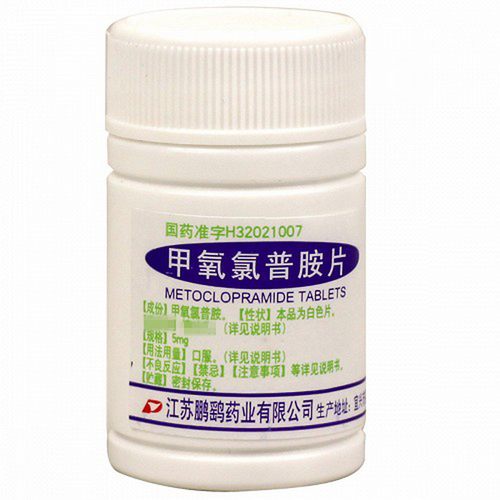Product Overview
【Drug Name】
Generic Name: Metoxopram Tablets
Brand Name: Yunpeng Metoxopram Tablets 5mg*100 tablets
Pinyin Code: YunPengJiaYangLvPuAnPian5mg*100Pian
【Main Ingredients】
Chemical Name: N-[(2-Diethylamino)ethyl]-4-amino-2-methoxy-5-chloro-benzamide
Molecular Formula: C14H22CIN3O2
Molecular Weight: 299.80
【Appearance】
This product is a white tablet.
【Indications/Main Functions】
Antiemetic. Mainly used for: 1. Symptomatic treatment of nausea, vomiting, belching, indigestion, abdominal distension, and hyperacidity caused by various etiologies; 2. Reflux esophagitis, bile reflux gastritis, functional gastric retention, and gastroptosis; 3. Delayed gastric emptying after vagotomy; 4. Gastric emptying disorders caused by collagen diseases such as diabetic gastroparesis, uremia, and scleroderma.
【Specifications】
5mg*100 tablets
【Dosage and Administration】
Oral administration. Adults: 5-10mg (1-2 tablets) three times daily. For patients with diabetic gastric emptying dysfunction, take 10mg (2 tablets) orally 30 minutes before symptom onset; or take 5-10mg (1-2 tablets) four times daily before meals and bedtime. The total dose should not exceed 0.5mg/kg/day. Children: 5-14 years old, 2.5-5 mg (1/2-1 tablet) three times daily, 30 minutes before meals. Short-term use is recommended. The total dose for children should not exceed 0.1 mg/kg/day.
【Adverse Reactions】
1. Common adverse reactions include drowsiness, restlessness, and fatigue;
2. Less common reactions include breast tenderness, nausea, constipation, rash, diarrhea, sleep disturbances, dizziness, severe thirst, headache, and irritability;
3. Increased milk production may occur during medication due to prolactin stimulation;
4. Long-term use of high doses may lead to extrapyramidal reactions (especially in young people) due to dopamine receptor blockade and relative cholinergic receptor hyperactivity, which may include muscle tremors, dysarthria, and ataxia.
【Contraindications】
1. The following conditions are contraindicated: ① Hypersensitivity to procaine or procainamide; ② Increased frequency and severity of epileptic seizures due to medication; ③ Increased gastrointestinal motility and worsening of conditions due to gastrointestinal bleeding, mechanical intestinal obstruction, or perforation; ④ Hypertensive crisis due to pheochromocytoma; Contraindicated in breast cancer patients experiencing vomiting due to chemotherapy or radiotherapy.
2. Use with caution in the following conditions: ① Liver failure, resulting in loss of protein binding capacity; ② Renal failure, i.e., severe chronic renal failure, increases the risk of extrapyramidal reactions, and the dosage should be reduced.
【Drug Interactions】
1. When used concurrently with acetaminophen, levodopa, lithium compounds, tetracycline, ampicillin, ethanol, and diazepam, gastric emptying is accelerated, leading to increased absorption of the latter in the small intestine; 2. Concurrent use with ethanol or central nervous system depressants enhances the sedative effect; 3. Antagonistic effects occur when used with anticholinergic drugs and anesthetic analgesics; 4. When used with antimuscarinic narcotic sedatives, the motility of metoclopramide in the gastrointestinal tract can be neutralized; 5. Due to its ability to release catecholamines, caution should be exercised when using it in hypertensive patients currently using monoamine oxidase inhibitors. 6. Concomitant use with acetaminophen, tetracycline, levodopa, ethanol, or cyclophosphamide may increase their absorption in the small intestine; 7. Concomitant use with apomorphine may inhibit both the central and peripheral effects of the latter; 8. Concomitant use with cimetidine or slow-dissolving digoxin may reduce the gastrointestinal absorption of the latter; this effect can be reduced by taking them 2 hours apart; this product may also increase the bile excretion of digoxin, thereby altering its blood concentration; 9. Concomitant use with drugs that can cause extrapyramidal reactions, such as phenothiazines, may increase the incidence and severity of extrapyramidal reactions.
【Precautions】
1. Aldosterone and serum prolactin concentrations may increase with the use of metoclopramide; 2. The dose should be reduced by at least 60% in patients with severe renal insufficiency, as these patients are prone to extrapyramidal symptoms; 3. Because this product can reduce the oral bioavailability of cimetidine, if the two drugs must be used together, the interval should be at least 1 hour; 4. The toxicity of this product increases after it turns yellow or yellowish-brown upon exposure to light.
【Pediatric Use】
Not suitable for long-term use in children.
【Geriatric Use】
Elderly patients should not use this product in large doses for extended periods, otherwise extrapyramidal symptoms are likely to occur.
【Overdosage】
1. Symptoms of overdosage: deep drowsiness, confusion; muscle spasms, such as neck and back muscle spasms, dragging gait, head and facial twitching movements, and trembling and shaking of the hands, etc., are all extrapyramidal symptoms. 2. In case of overdosage, the use of anticholinergic drugs, Parkinson's disease medications, or antihistamines can help suppress extrapyramidal reactions.
【Pharmacology and Toxicology】
This product is a dopamine D2 receptor antagonist and also has an agonist effect on serotonin D4 receptors, with a mild inhibitory effect on 5-HT3 receptors. It can act on dopamine receptors in the medullary chemoreceptor zone (CTZ) to increase the CTZ threshold, exhibiting a strong central antiemetic effect. This product can also block hypothalamic dopamine receptors, inhibit prolactin-inhibiting factor, and promote prolactin secretion, thus having a certain galactagogue effect. Its inhibitory effect on other central nervous system sites is mild, it has a weak sedative effect, and rarely induces hypnosis. Its effects on the gastrointestinal tract are primarily in the upper digestive tract, promoting the motility of the stomach and upper intestinal segments; increasing the tension of the resting gastrointestinal sphincters and the amplitude of contraction of the lower esophageal sphincter, thus increasing pressure in the lower esophagus, inhibiting gastroesophageal reflux, strengthening gastric and esophageal peristalsis, and enhancing the clearance of esophageal contents, thereby promoting gastric emptying; it also promotes relaxation of the pylorus, duodenum, and upper jejunum, fostering functional coordination between the gastric antrum, body, and upper small intestine. These effects may also enhance the antiemetic effect of this product. Its transit effects on the small intestine and colon are still uncertain.






